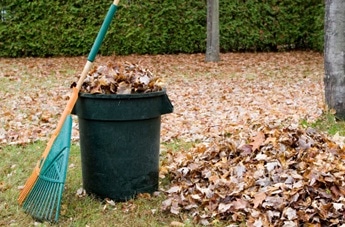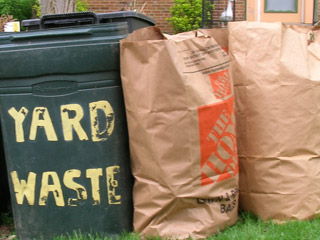Tips/Articles,
What NOT to Put in With Your Yard Waste
Oct 27 2017

Just as it is important to recycle properly so as not to contaminate the recycling stream (and potentially wind up with your well-intentioned recycling heading to a landfill) it is important to keep the yard waste you place at the curb “clean”.
Yard waste was banned from Illinois landfills in 1990, making it illegal for residents to put yard waste in with household garbage, and for good reason. Instead, yard waste is collected, often in curbside programs, and taken to commercial composting facilities where the grass clippings, leaves, branches and plant trimmings are allowed to rot in a huge compost pile. Composting yard waste saves TONS of space in landfills, reduces greenhouse gas emissions from organic waste breaking down in the anoxic environment of a landfill, and creates a nutrient rich, natural fertilizer (or “soil amendment” if you want to use the technical term).

A commercial compost facility. The large compost piles are called “windrows”.
What Doesn’t Belong?
The big piece to note here is that yard waste is composted (unless you live in the City of Chicago…but that’s another story). So your yard waste container shouldn’t be viewed as an all-purpose trash bin for the yard. That means that only natural, biodegradable materials should be placed in your yard waste collection – no metal and no plastic of any kind.
What are some of the top culprits trespassing in people’s yard waste?
- Balls – golf balls, soccer, football or tennis balls, baseballs/softballs – no balls!
- Animal waste (ahem, dog poop)
- Rubber Hoses – These are not compostable! Few (if any) are 100% natural rubber so keep them out.
- Small Plastics – Plastic bits that may have blown onto your lawn or been chopped up during mowing.
- Plant Pots – Plastic, ceramic or otherwise.
- Plant Ties & Netting – most of these items are plastic, if in doubt, keep them out!
- Garden Tools – Just because the handle may be wooden doesn’t mean it’s compostable.
- Treated Wood (including Railroad Ties)
- Plastic Bags
Keep It Clean
Making sure your yard waste is “clean” only requires a small amount of work to make sure you don’t rake up non-compostable debris. During the growing months, simply do a quick sweep of the yard and garden for litter, toys, and the like before you start mowing. It’s easier to spot and pick up larger items than sliced and diced ones after all, plus it protects your mower. You’ll thank yourself for doing this before the leaves begin falling.
In the fall, do a quick search again before raking leaves. If you trim back plants, make sure to remove plastic support ties or string before stuffing the clippings in with yard waste. Make sure not to accidentally rake up plastic netting holding down grass seed. If composting branches, be sure to bundle them with biodegradable twine.

Two good examples of containers for yard waste. Not a plastic bag in sight!
Lastly, make sure to place your yard waste in a paper yard waste bag or a clearly labeled reusable container. You don’t want to defeat your efforts by throwing all your compostable yard waste into a non-biodegradable plastic bag.
Final Eco-Wisdom
Rather than going to all the effort and expense of bagging up yard waste and putting it at the curb, consider a few ways you can use it at home.
- Leaves and grass clippings can provide a lot of nutrients for your lawn and soil. Just go right over leaves with the mower so they break down faster (a mulching mower makes this really easy).
- Use fall leaves as mulch for you garden beds. This practice has many benefits.
- Compost your yard waste at home. You need dried out leaves for home composting, especially if you compost food scraps.
- Make “leaf mold” for the garden.
- If you like to have fires (indoors or out), logs and branches are free fuel! Be sure to store them properly and allow enough time for the wood to dry out before using.
- Skip yard waste clean up altogether! Or at least, wait until spring to do so. Leaving your yard in it’s natural state during the winter helps make it a haven for native wildlife such as birds and beneficial insects.
Happy gardening!
If you enjoyed this post consider making a monetary donation to SCARCE so that we can continue to provide helpful information and insight.